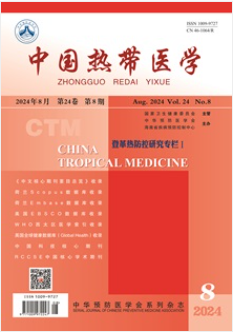Spatial analysis of COVID-19 epidemic situation of Yunnan
引用次数: 0
Abstract
Objective To analyze the spatial distribution characteristics of coronavirus disease 2019 (COVID-19) epidemic of Yunnan province, and we provide targeted prevention and control advice. Methods From 23 January to 22 February 2020, geographic information system was established based on the data of COVID-19 epidemic and demographic information from online reporting system, local indication of spatial auto correlation (LISA) were conducted by GeoDa1.14.0 and Mapinfo 15.0 software. Results Except for Diqing and Nujiang in 16 prefectures (cities) of the province, cases were reported in 14 other prefectures (cities). Among them, the confirmed cases were mainly reported in economically developed regions and regions with more developed tourism industry. The epidemic situation of COVID-19 in Yunnan Province first increased sharply and then decreased slowly. There was no statistical difference in global autocorrelation in incidence, but there were some areas aggregated, local clusters appeared only in the early stages of the epidemic. There were 3 L-L clusters (Dehong, Banna and Zhaotong) 1 H-L cluster (Kunming), 4 L-H clusters (Yuxi,Qujing, Chuxiong and Honghe) of early outbreak. Spatial aggregation gradually disappears over time. Conclusion The previous epidemic situation can be prevented and controlled, and there is no space aggregation, but before the epidemic situation is completely extinguished, we still need to improve our alertness, with scientific and correct methods to prevention and control, and avoid the new outbreak and epidemic. 摘要:目的 分析云南省新型冠状病毒肺炎疫情的空间分布特征,为制定云南省疫情防治措施和疫情的有效控制 提供有效参考。 方法 2020年1月23日至2月22日期间,基于全云南省通过疫情信息报告管理系统进行网络报告的 新型冠状病毒肺炎疫情数据和云南省统计局统计的云南省常驻人口信息,导人GeoDa1.14.0和Mapinfo15.0软件,进行 云南省新型冠状病毒肺炎疫情的描述和空间自相关分析。 结果 全省16州(市)除迪庆州和怒江州无病例报告外,其 他14个州(市)均有病例报告 , 其中确诊报告数主要集中在经济较发达的地区和旅游业较发达地区,云南省新型冠状病 毒肺炎疫情出现先急剧升髙后缓慢下降的趋势,发病率全局的空间自相关无统计学差异,但局部有一定的聚集,局部 地区聚集情况仅出现在疫情较早期,疫情早期存在3个L-L聚集区(德宏州、版纳州和昭通市),1个H-L区(昆明市),4个L-H区(玉溪市、曲靖市、楚雄州和红河州),随着时间的推移,空间聚集情况逐渐消失。 结论 目前疫情可防可控, 无空间聚集性 , 但是在疫情完全扑灭前,仍然需要我们提髙警觉性 , 科学防控 , 避免疫情的再燃和空间的聚集。云南省新冠肺炎疫情空间分析
目的分析云南省2019冠状病毒病(COVID-19)疫情的空间分布特征,为有针对性的防控提供建议。方法于2020年1月23日至2月22日,基于新冠肺炎疫情数据和在线报告系统的人口统计信息,建立地理信息系统,利用GeoDa1.14.0和Mapinfo 15.0软件进行空间自相关局部指示(LISA)。结果全省16个地(市)除迪庆和怒江外,其余14个地(市)均有报告病例。其中,确诊病例主要集中在经济发达地区和旅游业较为发达的地区。云南省新冠肺炎疫情呈先急剧上升后缓慢下降趋势。发病率的全球自相关性无统计学差异,但存在部分地区聚集性,局部聚集性仅在疫情早期出现。早期暴发有3个L-L聚集区(德宏、版纳、昭通),1个H-L聚集区(昆明),4个L-H聚集区(玉溪、曲静、楚雄、红河)。随着时间的推移,空间聚集逐渐消失。结论以前的疫情是可以防控的,不存在空间聚集,但在疫情完全熄灭之前,我们仍需提高警觉性,用科学正确的防控方法,避免新的疫情和流行。摘要:目的 分析云南省新型冠状病毒肺炎疫情的空间分布特征,为制定云南省疫情防治措施和疫情的有效控制 提供有效参考。 方法2020年1月23日至2月22日期间,基于全云南省通过疫情信息报告管理系统进行网络报告的新型冠状病毒肺炎疫情数据和云南省统计局统计的云南省常驻人口信息,导人GeoDa1.14.0和Mapinfo15.0软件,进行云南省新型冠状病毒肺炎疫情的描述和空间自相关分析。结果全省16个州(市)除迪庆州和怒江州无病例报告外,其他14个州(市)均有病例报告,其中确诊报告数主要集中在经济较发达的地区和旅游业较发达地区,云南省新型冠状病毒肺炎疫情出现先急剧升髙后缓慢下降的趋势,发病率全局的空间自相关无统计学差异,但局部有一定的聚集,局部地区聚集情况仅出现在疫情较早期,疫情早期存在3个L-L聚集区(德宏州,版纳州和昭通市),1个h l区(昆明市),4个L-H区(玉溪市,曲靖市,楚雄州和红河州),随着时间的推移,空间聚集情况逐渐消失。结论 目前疫情可防可控, 无空间聚集性 , 但是在疫情完全扑灭前,仍然需要我们提髙警觉性 , 科学防控 , 避免疫情的再燃和空间的聚集。
本文章由计算机程序翻译,如有差异,请以英文原文为准。
求助全文
约1分钟内获得全文
求助全文
来源期刊
CiteScore
0.60
自引率
0.00%
发文量
13927
期刊介绍:
China Tropical Medicine, was approved by the Ministry of Science and Technology in 2001, is the only tropical medicine periodical under the charge of the National Health Commission of China. It’s organized by Hainan Provincial Center for Disease Prevention and Control, and Chinese Preventive Medicine Association.
The journal is indexed by the following database: Scopus database, Embase database, EBSCO Database, The Western Pacific Region index medicus (WPRIM), American Chemical Abstracts (CA), International Centre for Agricultural and Biological Sciences Research Database (CABI), Global Health Database, Database of the Ulrich's Periodicals Directory, China Science and Technology Core Journals, China Core Journals (Selection) Database, Database of Chinese Biomedical Literature, Comprehensive Evaluation Database of Chinese Academic Journals, CAJCD Code of Conduct Excellent Journal, Database of Chinese SCI-Tech Periodicals, China Journal Full Text Database.

 求助内容:
求助内容: 应助结果提醒方式:
应助结果提醒方式:


